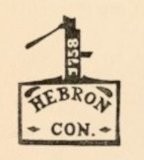
The Hebron Historical Society
Hebron, Connecticut
Enjoy Hebron - It's Here To Stay ™


This building was moved to Hebron Center from the Gull section of Old Colchester Road. It is a district school and represents how children in the 1800’s would receive their education. Older and younger students would all learn in the same room, but be taught different lessons which they would then memorize and recite out loud. By colonial and then state law, colonial towns had to provide schools for their residents. One of the purposes of property taxes was to finance schools and school teachers. In an age before gasoline powered engines, children had to walk to school or go by horse and buggy. Towns divided their area up into school districts. In 1870, Hebron had 11 school districts. Many of these one-room schools still stand in Hebron. Charles M. Profit, a young African American boy, who lived on the Northam family farm went to school here learning his lessons along with Yankee children. As you travel through Connecticut, see if you can spot former one room schools now turned into houses.
Think about it
Are you ever asked to memorize a lesson and recite it back? Why at a time when books and paper were somewhat expensive would using memorization skills be useful? How is this school similar or different from the school you attend(ed)?
In 1798 close to this area a prosperous African American farmer named Eber Oran had a large house with 4 fireplaces assessed at the 3rd rate suggesting it was an old two-story house. Eber Oran paid a poll tax which enabled him to vote. The right of African Americans to vote was abolished by the Connecticut Constitution of 1818 which disestablished the Congregational Church as the state church. In 1798, Eber Oran was assessed as having a yoke of oxen, two cows, one two-year old cow and a horse. The listing for his land was crossed out suggesting that he might have rented the farm on which he lived. That farm had 14 acres of plowland, 16 acres of mowing lot, 5 acres of bog meadow and 52 acres of bush pasture. By 1811, Jesse Boham, an African American youth, was indentured to Eber Oran, but ram away causing his master to put advertisement in the newspaper for his return to finish his indenture.
Where to go next
From the Gull Schoolhouse walk toward the Hebron Town Office building to the WW II Civilian Watch Station.
Meet Your Neighbors QR Tours funded by the Hebron Greater Together Community Fund in conjunction with the Hebron Historical Society